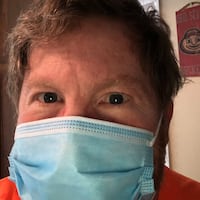Patients in intensive care units and on ventilators in those counties was climbing toward the highest levels of the pandemic locally so far: On Wednesday, 148 people were in ICUs, with 143 of them on ventilators, in the combined region that includes Butler, Warren and Hamilton counties, and also extends to Clermont, Brown, Adams, Highland and Clinton counties.
Help for health care urged
Dr. Keith Bricking, president of Atrium Medical Center in Middletown, urged the public: “If you are not vaccinated, please, please go get vaccinated.”
He said hospital staffing has been limited locally and nationally because medical professionals are so stressed.
“Many health caregivers, specifically nurses, are leaving the bedside due to the stress and workload of the past 18 months,” Bricking said, calling Atrium’s team “amazingly resilient” during that time.
“They remain heroes on many levels, but they are tired, emotionally and physically fatigued,” he said. “They need the continued support of our community, and the best way to do that now is for the community to educate themselves on the benefits of the COVID vaccine.”
Medical-staff losses make the upward trend in ICU and other COVID hospitalizations even more frightening, said Christa Hyson, assistant director for emergency response and spokeswoman for The Health Collaborative, which covers hospitals across that area. That’s because if they’re treating the same number of patients, they’re doing it “with a fraction of the staff.”
In the Health Collaborative’s region, numbers of patients in ICUs since early August have been at levels that cause “moderate to extreme strain on staffing” and nearing a level of “extreme strain,” it said.
Occupancy of non-ICU medical/surgical beds also has been in the moderate-to-extreme level most of the time since March, and also have risen lately.
Meanwhile, across the Dayton region there were 336 patients hospitalized with COVID-19, which translates to about 1 in 7 hospital patients having COVID-19. Two months ago, 13 patients were hospitalized with COVID-19 in that region.
A perfect storm
“We are in a perfect storm, with COVID, with respiratory disease, with mental-health issues,” said Dr. Patty Manning, chief of staff at Cincinnati Children’s Hospital Medical Center. “All of these things combined at this time of year are putting a significant strain on our hospital systems.”
“We all have this goal of keeping kids from getting sick so that they can attend in-person school, and learn, and do the things that they are designed to do as kids,” Manning said.
She also urged people to use tools, like vaccinations, adding, “We can say quite confidently that these are very, very safe tools to use to keep kids safe. In fact, the risk of a vaccine is miniscule, and practically non-existent.”
As with other area hospitals, elective surgeries are continuing at Kettering Health Hamilton, formerly Fort Hamilton Hospital, said its chief medical officer, Dr. Marcus Romanello.
Such surgeries “are often very crucial to a patient’s overall health, and so we are stretching as much as we possibly can to be able to care for all the patients in our community,” Romanello said.
“One of the most important things the average person can do is take this pandemic very seriously, support those in the hospitals and in the health-care environment who are doing the work and caring for our sickened brethren,” Romanello said.
People also can donate to hospital foundations, to help them provide expanded care to patients, he said.
Michael Everett, president of McCullough-Hyde Memorial Hospital and Bethesda Butler Hospital, encouraged people to get the vaccine. “We have to look to the people we trust whenever we’re sick, and that’s our medical professionals,” he said. “We trust them when we have heartburn or surgery. I trust them with this.”
He also recommended thoroughly washing hands, wearing masks, and doing generally healthy things, such as getting more sleep and exercising.
Hyson suggests people who resist vaccination talk with their doctors about it, or other medical professionals, such as a pharmacist. Otherwise, she suggested other sources that base their recommendations on legitimate scientific research, such as a local health department, a hospital or the Centers for Disease Control and Prevention.
Romanello said he regularly sees patients who considered themselves healthy but had underlying conditions, such as a body mass index over 30. Also, “This disease is sometimes indiscriminate, where two identical-appearing patients, one will have a mild course, and one will have a serious course,” he said.
Bricking warned people not to think youth will protect people from this disease: “We continue to see patients with COVID from all age groups, but compared to previous waves, we are seeing more younger patients hospitalized, more younger patients in the ICU with more days requiring hospitalization, and, sadly, more deaths in younger patients.”
Staff Writer Kaitlin Schroeder contributed.
About the Author

